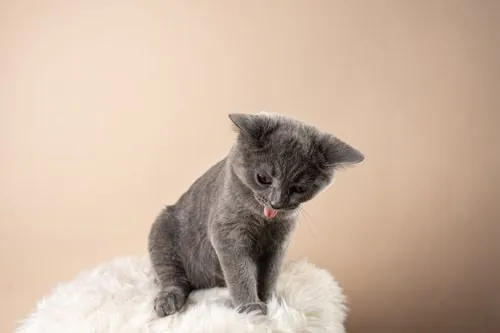Solving Litter Box Problems
 Dr. Kari Addante reports: Failure to use the litter box, even after years of seemingly following the rules, is a means of great frustration for many cat owners. Such problems are generally lumped in two broad categories: medical or behavioral. Medical problems are much easier to address and should always be considered first. Behavioral problems can be frustrating, but generally, in time cats will resume use of the litter box again after appropriate actions are taken. The aim of this article is not only to help those with a current problem but also to inform all cat owners of certain practices that can help reduce the possibility of litter box aversion for any cat.
Dr. Kari Addante reports: Failure to use the litter box, even after years of seemingly following the rules, is a means of great frustration for many cat owners. Such problems are generally lumped in two broad categories: medical or behavioral. Medical problems are much easier to address and should always be considered first. Behavioral problems can be frustrating, but generally, in time cats will resume use of the litter box again after appropriate actions are taken. The aim of this article is not only to help those with a current problem but also to inform all cat owners of certain practices that can help reduce the possibility of litter box aversion for any cat.
When there is more than one cat in the house, isolating one cat at a time can be a method of discovering the offending cat. However, isolation occasionally fails to identify the cat in question, and then more detective work can be required to solve the mystery. In such cases, the feeding of certain food additives, obtained from your veterinarian, will glow in the cat’s urine for about 24 hours after eaten with the aide of a black light. When cats defecate outside the litter box, then you can mix shavings from non-toxic crayons with your cat’s food. Using a different color for each cat will allow you to detect the kitty in question.
After identifying which cat has the issue, it is imperative to rule-out medical problems as a cause of failure to use the litter box. Going outside the box to urinate or defecate may be the first sign of a serious health problem that needs to be treated as soon as possible in order to avoid progression of illness which can eventually be life threatening. These conditions include feline lower urinary tract disease, arthritis, kidney disease, thyroid disease, diabetes, intestinal disease, and pain of any cause (e.g. dental disease) just to name a few. A thorough history, physical examination, blood work, and urinalysis are required to make an initial assessment of your cat’s health. Based on your cat’s age and the initial findings, other diagnostic tests may be needed. Males and females in the home must all be neutered or spayed as hormonal drive to mark territory is a substantial cause of litter box problems in the home.
Once medical conditions have been eliminated as a cause of litter box aversion, then it is necessary to carefully evaluate every aspect of the litter box and home as potential environmental causes for the behavior. Punishment is NEVER a solution for failure to use the litter box and will often serve only to worsen the problem. Box size, box type, litter type, location, number and availability of boxes as well as stress from any source must be considered.
As a starting point for all households, it is recommended to provide 1 box per cat plus one extra (i.e. 1 cat needs two boxes, 2 need three boxes, etc.). Boxes should be at least 1.5 times the length of the largest cat’s body (e.g. sweater boxes and storage containers). Boxes should be placed in quiet locations with at least 2 ways to enter or exit the area. Boxes should be scooped twice daily at a minimum. Clumping cat litter should be changed completely once each week and clay litter should be changed completely every other day. Boxes should be washed only with warm soapy water (i.e. avoid ammonia or pine scented cleansers, etc.) and rinsed well before replacing litter. Most cats prefer unscented litter and uncovered boxes.
After supplying the above basic litter box needs, it is necessary to methodically work through the possible causes and remedies to find a solution and allow 7- 10 days to assess the cat’s response to any environmental adjustment. This can require consideration of the location and surface type where your cat chooses to eliminate outside the box. Cleaning soiled floor or upholstered areas with special enzymatic products is always needed to breakdown the odor causing compounds that cats will detect otherwise. Sometimes blocking access to that area or placing food and water dishes at the site can discourage repeat offense. In addition, the synthetic feline pheromone Feliway® spray or diffuser can be used to reduce stress when that is thought to play a role in the problem. Multi-cat households should pay particular attention to providing adequate food, water and perching resources to avoid competition among cats. Consider that your cat may be bored or depressed, and provide environmental enrichment with interactive toys and treat dispensing balls. Finally, behavioral modifying drugs can be an option when other efforts fail to provide results. Because many variables can play a role in litter box aversion, it is always wise to work together with your veterinarian to reach a solution.
Recent Posts
About The Village Vets
The Village Vets is a network of animal hospitals based in Atlanta, GA and the surrounding area. We offer honest, excellent service to our clients in a comfortable, friendly atmosphere. To learn more about our locations and how we can better serve you and your pet, click the button below.
Share This Post
Recent Posts
About The Village Vets
The Village Vets is a network of animal hospitals based in Atlanta, GA and the surrounding area. We offer honest, excellent service to our clients in a comfortable, friendly atmosphere. To learn more about our locations and how we can better serve you and your pet, click the button below.



